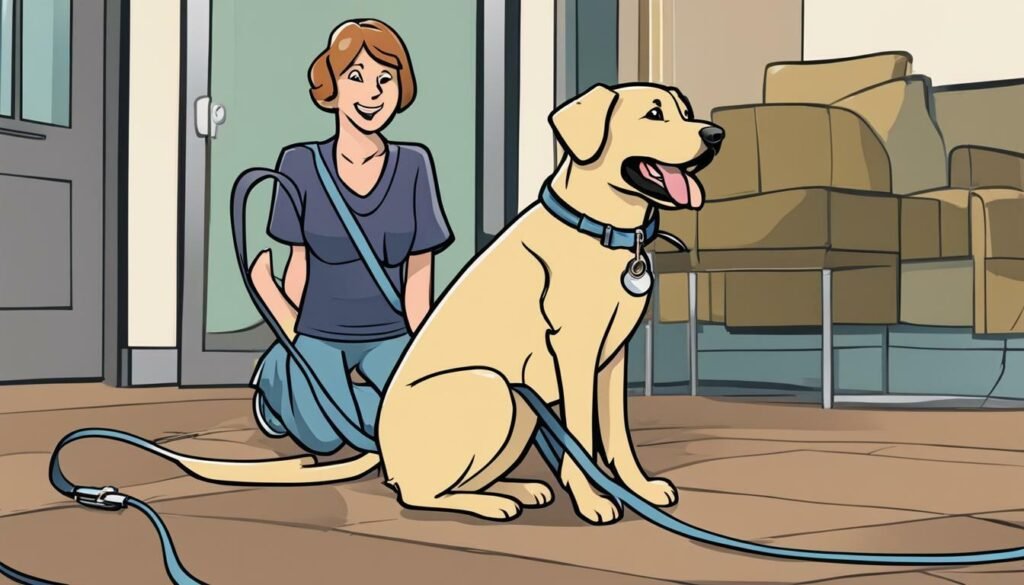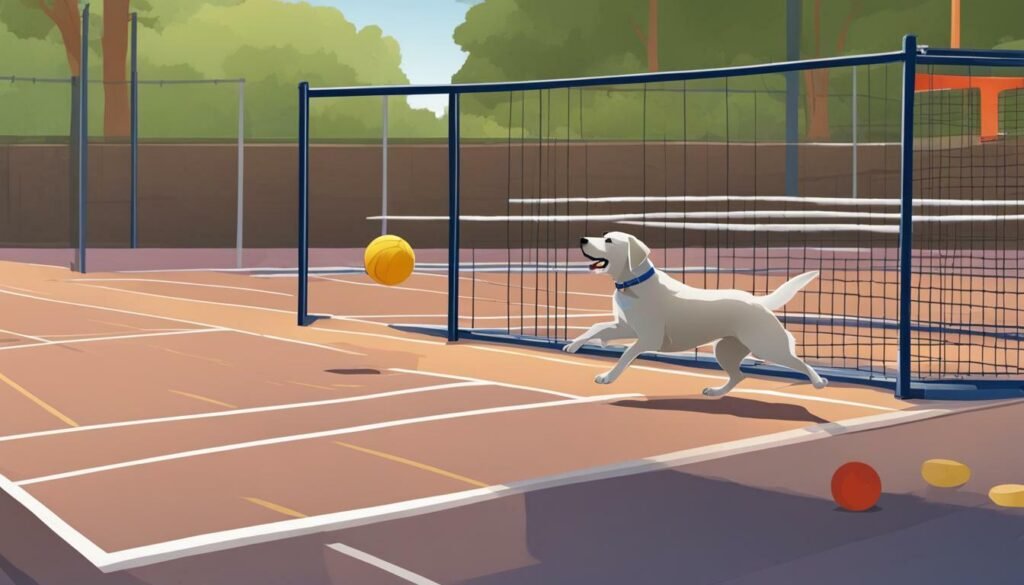If you’re a proud owner of a Labrador Retriever, you’re probably looking for ways to train your furry friend. Labrador Retrievers are intelligent and friendly dogs, but proper training is essential to ensure good behavior and obedience. In this guide, we’ll provide you with easy-to-follow steps and training techniques to help you train your Labrador Retriever effectively.

Key Takeaways
- Understanding your Labrador Retriever’s behavior is crucial before starting the training process.
- A consistent dog training schedule and incorporating crate training are essential for effective dog training.
- Teaching basic commands and using positive reinforcement techniques are fundamental to good behavior.
- Proper leash training is crucial for safe and enjoyable walks.
- Advanced dog training exercises can challenge your Labrador’s intelligence and enhance their skills.
Knowing Labrador Retriever Behavior
Training Labrador Retriever requires an understanding of their behavior. Known for their friendly and outgoing personality, Labradors are also highly energetic and intelligent animals. They were initially bred as working dogs, which means they have a strong instinct to hunt, retrieve, and explore their surroundings.
It’s important to recognize that they can also be very stubborn sometimes, which can make training challenging. However, with patience and persistence, you can train your Labrador Retriever to be an obedient and well-behaved companion.
One behavior that is typical of Labradors is their love for food. Treats can very motivate them, which makes positive reinforcement techniques such as clicker training and treats rewards effectively. Incorporating play into your dog training routine can help channel their energy into productive activities and strengthen the bond between you and your dog.
Labradors are also highly social and love to be around people. If left alone for long periods, they may become anxious and engage in destructive behavior, such as chewing on furniture or shoes. Therefore, crate training can be an effective way to provide your Labrador with a safe and cozy space of their own, while also helping to minimize their anxiety and prevent destructive behavior.

By understanding your Labrador’s natural tendencies and behaviors, you can tailor your training methods to your dog specific needs and ensure your lab receives the proper guidance and support he/she requires.
Setting Up a Training Schedule
Labrador Retriever training requires consistency and a well-thought-out training schedule. Establishing a routine helps your furry friend learn more effectively.
You should set aside a specific time daily for training sessions, ideally in a quiet and distraction-free environment. Before you start, ensure that you have your dog’s favorite treats on hand as rewards for good behavior.
One of the most crucial aspects of a training schedule is crate training. Using a crate helps keep your Labrador Retriever secure while you’re away and discourages destructive behavior. The crate should be large enough for your dog to stand up and turn around comfortably. Remember, never to use the crate as a punishment, as this undermines its use in training.

| Training Schedule Tips |
|---|
| Stick to a regular schedule |
| Keep training sessions short, around 10-15 minutes |
| Start with basic commands and progress to more advanced training exercises gradually |
| Be patient and consistent, rewarding good behavior and ignoring bad behavior |
By following a consistent training schedule, your Labrador Retriever will learn faster and better. Remember to be patient and use positive reinforcement, and your furry friend will be a well-behaved and obedient companion in no time.
Basic Training Commands To Train a Labrador Retriever
If you’re wondering how to train a Labrador Retriever, teaching basic commands is crucial. Start with simple commands like “sit,” “stay,” “lie down,” and “come.”
To teach your Labrador Retriever to sit, hold a treat close to their nose, and move your hand up. As their head moves up, their bottom should naturally lower. When their bottom hits the floor, say “sit” and give your dog the treat. Repeat this exercise until they learn the command.
To teach your Labrador Retriever to stay, ask them to sit first. Then, hold your hand up like a stop sign and say “stay”. Take a step back, and if your dog remains in position, reward your dog with a treat. Gradually increase the distance and duration of the stay.
To teach your Labrador Retriever to lie down, ask them to sit first. Then, hold a treat close to the floor and slowly move it away from them. As they follow the treat, their body should naturally lower to the ground. When they are lying down, say “lie down” and give them the treat. Repeat this exercise until they learn the command.
To teach your Labrador Retriever to come, put a long leash on your lab and let him/her roam. Then, say “come” and gently pull the leash. When your lab come towards you, give him/her a treat. Repeat this exercise until your lab come to you with no leash.

Remember to use positive reinforcement techniques like treats and praise to motivate your Labrador Retriever during training. Consistency and patience are also key to successful training.
Use Positive Reinforcement Training Techniques
Training your Labrador Retriever using positive reinforcement is a highly effective and humane approach. Positive reinforcement involves rewarding good behavior rather than punishing bad behavior. This method of training can teach any behavior or command you want your Labrador Retriever to learn, from basic commands to more advanced tricks.
In positive reinforcement training, it is important to provide immediate rewards to your Labrador Retriever as soon as your dog fulfills the desired behavior. The reward should be something that your dog finds enjoyable, such as dog treats, praise, or playtime.
One of the most important aspects of positive reinforcement training is consistency. You should always reward your Labrador Retriever for good behavior and never punish them for bad behavior. Punishing your dog can lead to fear and anxiety, which can hinder their learning.
Here are some tips for using positive reinforcement in your training:
- Use treats that are small and soft, so your Labrador Retriever can easily eat them.
- Be enthusiastic about your praise. Your dog will be more motivated to learn if they can sense your excitement.
- Give rewards immediately after your dog performs the desired behavior. This will help your dog associate the behavior with the reward.
Positive reinforcement training can teach basic commands, such as sit, stay, lie down, and come. It can also teach more complex behaviors, such as fetching and retrieving.
Remember, patience is key when training your Labrador Retriever. Every dog learns at their own pace, so it’s important to be patient and consistent in your training.

Leash Training and Walking
Leash training is a crucial part of raising a well-behaved Labrador Retriever. Before you start training your lab, make sure you have a high-quality leash that is the right length for your dog’s size. Shorter leashes are better for larger dogs, while longer leashes are ideal for smaller dogs.
The first step in leash training your Labrador Retriever is to introduce your dog to the leash. Let your dog sniff and investigate it without getting too excited. Once your dog is comfortable around the leash, attach it to their collar and let your dog walk around with it for a few minutes.
When you’re ready to start walking, keep the leash loose but be prepared to smoothly correct your dog if your dog pulls. If your dog pulls, stop walking and wait for your dog to calm down before continuing. Consistency is key here. If you allow your dog to pull on the leash sometimes but not others, your dog will become confused and frustrated.
Another crucial aspect of leash training is teaching your Labrador Retriever to walk on your left side. Start by walking with your dog on a loose leash, holding a treat in your left hand. Encourage your dog to walk on your left side by offering your dog the treat. When your dog gets there, reward your dog with the treat and praise. Repeat this process until your dog is consistently walking on your left side.

Using Positive Reinforcement
Positive reinforcement is a powerful tool in leash training and walking your Labrador Retriever. Whenever your dog walks nicely on a leash, offer your dog a treat or some praise. This positive feedback will encourage your dog to continue walking nicely and make leash training a fun and rewarding experience for both of you.
Remember, leash training takes time and patience. Be consistent with your training, and your Labrador Retriever will soon walk nicely on a leash.
Addressing Behavioral Issues
Labrador Retrievers are popular dog and known for their friendly and outgoing personalities, but sometimes they can develop certain behavioral issues that require attention during the training process. This section will cover some common issues and provide training techniques to address them.
Crate Training for Labradors
One of the most common behavioral issues that Labrador Retrievers may experience is separation anxiety. Crate training can help to ease their anxiety by providing your dog with a safe and comfortable space to relax while you’re away.
Start by introducing your Labrador to the crate gradually, allowing your dog to explore and get comfortable with it. Once your dog is comfortable going in and out of the crate, begin training your dog to stay in the crate for short periods of time while you’re home. Gradually increase the time that they spend in the crate, rewarding your dog with treats and praise when your dog remains calm and relaxed.
It’s important to never use the crate as punishment. Instead, make it a positive and comfortable space for your Labrador to retreat to when your dog needs a break.
Labrador Retriever Behavior Training
If your Labrador is exhibiting unwanted behaviors, such as jumping up or chewing on furniture, it’s important to address these issues as soon as possible. Consistency is key when training any behavior, so make sure to provide clear rules and consequences for your Labrador’s actions.
For jumping, instruct your Labrador to sit and reward your dog with treats and praise when your dog follows through. Consistently reinforcing this behavior will teach your Labrador to sit instead of jumping when your dog greets people.
To prevent chewing, provide your Labrador with plenty of chew toys and teach your dog what is and isn’t appropriate to chew on. If you catch your dog chewing on something your dog shouldn’t be, redirect their attention to an approved chew toy and provide lots of praise when your dog engages with it.
Remember, training a Labrador Retriever takes time and patience. With consistency and positive reinforcement, you can help your furry friend develop good behaviors and prevent unwanted ones.

Advanced Training Exercises
Congratulations! Your Labrador Retriever has successfully mastered basic commands and has developed good behavior. It’s time to introduce some advanced training exercises to challenge your furry friend’s intelligence and enhance their skills. In this section, we will introduce some of the best training methods and exercises for Labrador Retrievers.
Retrieving Multiple Objects
Labrador Retrievers are natural retrievers, and they love to fetch and retrieve objects. This exercise involves teaching your Labrador to retrieve multiple objects and bring your dog back to you. Start by teaching your lab to retrieve one object and gradually increase the number of objects. This exercise improves your lab’s focus and strengthens their retrieving abilities.
Off-Leash Training
Teaching your Labrador to obey commands off-leash is a significant achievement in advanced training. Start in a safe, enclosed area and gradually increase the distance between you and your dog. Ensure your lab responds to basic commands such as ‘come’ and ‘stay’ before taking off the leash entirely. Be patient and consistent, and your Labrador will run freely in no time.
Agility Training
Agility training is a great way to improve your lab’s physical fitness and cognitive skills. Set up an obstacle course with hurdles, tunnels, and weave poles. Start with simple exercises and gradually increase the difficulty level. This exercise is not only challenging, but also fun for both you and your furry friend.
Training for Specific Tasks
If want to train your Labrador Retriever for specific tasks such as hunting, search and rescue, or therapy work, specialized training programs are available. These programs focus on developing specific skills and techniques tailored to each task and are an excellent way to enhance your lab’s natural abilities.
Remember, advanced training exercises require patience, consistency, and a positive attitude. Do not rush your Labrador Retriever and always remember to use positive reinforcement. With dedication and hard work, your lab will be an intelligent and obedient companion.

Final Thought
Congratulations! You are now equipped with the knowledge, and skills needed to train your Labrador Retriever successfully. Remember to be patient, consistent, and use positive reinforcement techniques. Your Labrador Retriever will thrive under your guidance, and you will have a loyal, obedient companion for life.
Always keep in mind that training should be a fun and rewarding experience for both you and your dog. Enjoy the process and don’t be afraid to try new techniques and activities to challenge your Labrador’s intelligence and enhance their skills.
If you encounter any behavioral issues or have questions, reach out to a professional dog trainer for guidance. They can provide additional support and guidance for you and your Labrador Retriever.
With dedication and hard work, your Labrador Retriever will become a well-behaved and obedient companion that you can be proud of. Good luck with your training journey!
FAQs
How long does it take to train a Labrador Retriever?
The duration of Labrador Retriever training can vary based on factors such as the dog’s age, previous training experience, and consistency. However, it typically takes several weeks to months to fully train a Labrador Retriever.
What are some important Labrador Retriever training tips?
Some key Labrador Retriever training tips include using positive reinforcement, being consistent with commands and rewards, keeping training sessions short and engaging, and seeking professional help if needed.
How often should I train my Labrador Retriever?
we recommend it to train your Labrador Retriever for short sessions multiple times a day. This helps maintain their focus and prevents them from becoming bored or overwhelmed.
Can Labrador Retrievers be trained to do tricks?
Yes, Labrador Retrievers are intelligent dogs that can be trained to perform a variety of tricks. With patience, consistency, and positive reinforcement, you can teach your Labrador Retriever fun tricks like roll over, shake hands, and play dead.
Is it necessary to use a crate for Labrador Retriever training?
Using a crate can be beneficial for Labrador Retriever training, especially during housebreaking and when you need to leave them unsupervised. Crates provide a safe and secure space for your dog and can help prevent accidents and destructive behavior.
What should I do if my Labrador Retriever shows aggressive behavior?
If your Labrador Retriever displays aggressive behavior, it is crucial to seek professional help from a certified dog trainer or behaviorist. They can evaluate the situation, identify the cause of the aggression, and provide guidance and training techniques.
